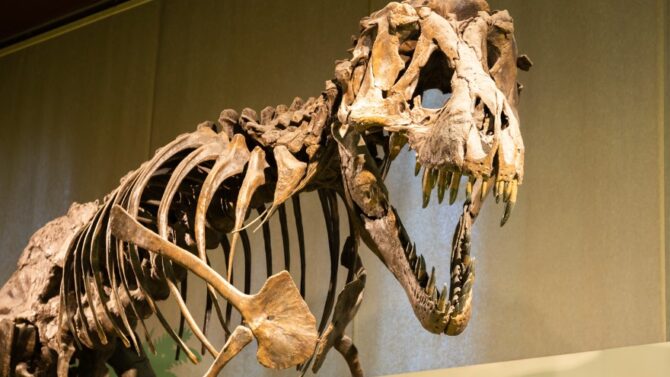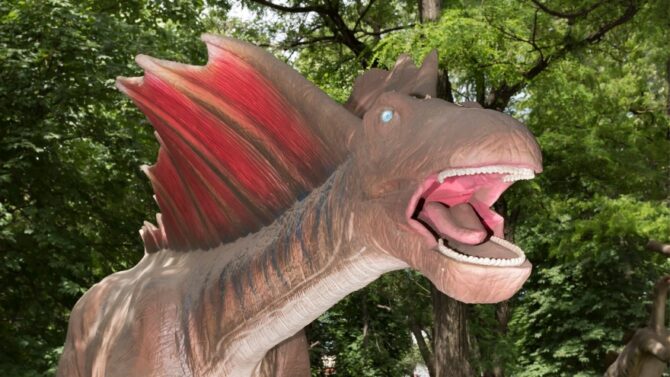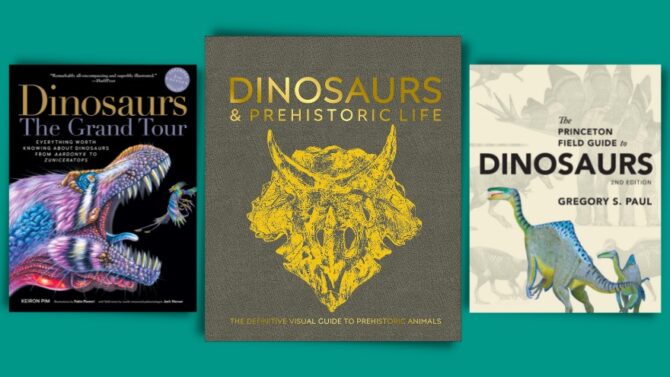Science and history estimate dinosaurs‘ extinction about 65 million years ago, but did dinosaurs and humans coexist?
The idea that these ancient reptiles lived alongside humans in the past or are still alive today is a familiar opinion among young Earth creationists and other groups.
However, others believe this supposed claim conflicts with scientific theories by misrepresenting historical records due to religious beliefs and other reasons.
As such, deliberating on the topic is not out of place.
Did Dinosaurs and Humans Coexist?
The idea that dinosaurs and humans coexisted is a common misconception that has been popularized by media and fiction. However, there is no scientific evidence to support this notion.
In fact, the fossil record clearly shows that the last dinosaurs lived approximately 65 million years ago, while the earliest known human species, Homo habilis, appeared on Earth only about 2.5 million years ago.1
Numerous studies and research have been conducted to investigate the possibility of dinosaurs and humans coexisting, including analyses of geological and paleontological records.
But no evidence has been found to suggest that they overlapped in time.
While some ancient cultures may have created mythological tales involving dragons or other large reptiles, these tales are not based on any factual observations of living dinosaurs.
Fiction and Mythology About Human-Dinosaur Coexistence
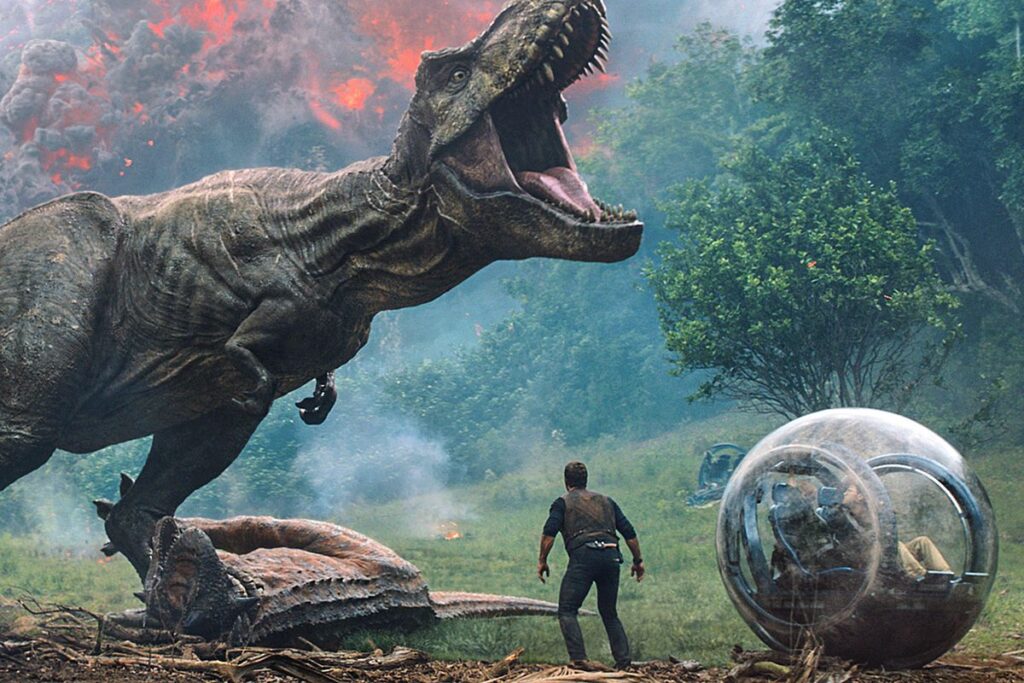
Fictitious theories often portray non-avian dinosaurs with humans, evidenced by sci-fi books, movies, and cartoons.
Our claim readily brings to mind the 20th-century American animated sitcom, The Flintstones, portraying two siblings and their pet dinosaur.
The 1960s comic series the Cavern Clan also shows its main act, a caveman hunting dinosaurs, and the list is worth a whole page.
Worse still, the idea of human-dinosaur coexistence is present in more attention-worthy materials of theory advocates that claim mythological reptiles like dragons are historical portrayals of dinosaurs.
Examples include widely publicized, convincing falsehoods that gull victims into believing the coexistence of dinosaurs with humans.
Sadly, those behind these hoaxes propose them as historical portrayals of dinosaurs.
The Ica stones of Ica Province, Peru, portray supposed ancient depictions of dinosaurs and popularize them as real ancient artifacts.2
However, unreliable dating methods de-established the conclusion that these stones convincingly depict human-dinosaur coexistence.
Some young Earth creationists have used these stones to solidify their claim that humans and dinosaurs once roamed the earth at a specific era.
Regardless, it opposes carbon-dated fossil records that estimate dinosaur extinction millions of years before humans.
Exclusive Dominance During the Mesozoic Era
While humans are the prime intelligent creatures in the animal kingdom, dinosaurs were dominant for about 165 million years of the Mesozoic Era.
Sadly, their domination terminated at the end of the Cretaceous Period after an asteroid wiped out roughly eighty percent of life on earth.3
While humans likely never lived amongst dinosaurs, some small mammals resided amongst these mammoth beasts in their final years.
As warm-blooded animals, many of these species endured the asteroid catastrophe that dinosaurs could not withstand.
Millions of years later, humans would live amongst their descendants, birds.
Birds are the Only Living Dinosaurs
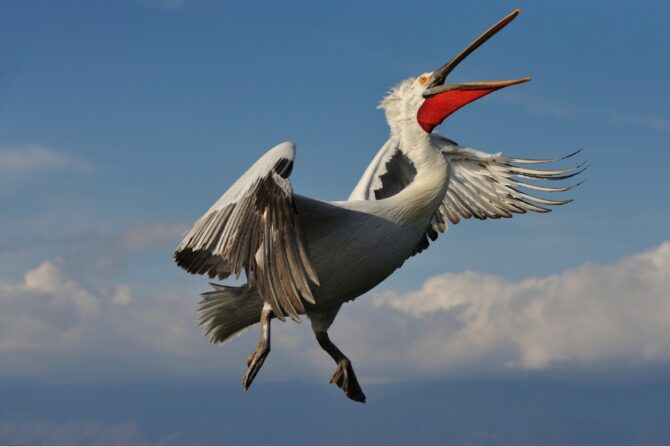
Scientists, through credible studies, believe that all birds are dinosaurs; modern-day birds evolved from feathered theropods or avian dinosaurs.
However, this evolution took several years of constant modification before these feathered creatures became what they are today.
While modern-day reptiles are cold-blooded animals, evolving proofs infer that many dinosaurs were warm-blooded.
Feathered species grew colorful plumes, and avian dinosaurs had ecological behaviors similar to modern birds.
The human-dinosaur claim holds credence only by the broad and technical interpretation of birds evolving from dinosaurs.
Therefore, humanity has lived alongside dinosaurs since appearing on earth.
Contrastingly, in a bounded meaning of “dinosaur,” which refers specifically to non-avian, reptilian dinosaurs, and humans never existed with the titanic beasts.
Non-avian dinosaurs suffered the Cretaceous–Paleogene extinction about 65 million years ago.
In comparison, the first Homo species emerged about 3 million years ago, a ten-million-year period between the last dinosaurs and the first humans.
Related: Birds That Look Like Dinosaurs
Frequently Asked Questions (FAQs)
Did all the dinosaurs live together and at the same time?
Dinosaurs lived at different geological periods and across various geographical ranges.
The ‘Dinosaur Age’ (the Mesozoic Era) covered the Triassic, Jurassic, and Cretaceous Periods, with different dinosaur species living during these three periods in various locations.
When did dinosaurs become extinct?
Dinosaur extinction occurred about 65 million years ago, toward the end of the Cretaceous Period, after a 165-million-year period on earth.
These titanic reptiles dominated the Mesozoic Era, being the largest and some of the fiercest animal species.
Why did some dinosaurs grow so big?
Scientists cannot specifically tell the reason behind dinosaurs’ large body sizes but speculate it was an anti-predator technique.
It also aided body temperature regulation and helped them reach new food sources.
The modern world’s largest animal species, whales, are the only creatures compared to the largest dinosaurs.
Thus, the dinosaurs’ world supported their existence with the climatic conditions and food supplies that supported their large size.
Were dinosaurs cold or warm-blooded?
Differing opinions exist on the subject of dinosaurs’ thermoregulation and metabolism, with some scientists speculating whether these reptiles were warm or cold-blooded.
While modern-day reptiles are cold-blooded species, these ancient large-sized animals might have been warm-blooded to support their body size.
However, smaller non-avian reptilian dinosaurs were most likely cold-blooded.
Wrap Up
The human-dinosaur coexistence is a controversial subject between paleontologists and Young Earth creationists.
However, more evidence proves the correctness of paleontologist theories.
Scientific and historic records about early human existence indicate that humans never lived amongst non-avian reptilian dinosaurs.
References & Notes
- When Did Dinosaurs Live? Natural History Museum.
- The Ica Stones of Peru. Tracking Ancient Man.
- Cretaceous Period. National Geographic.


